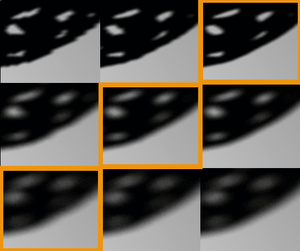Information
- Publication Type: Master Thesis
- Workgroup(s)/Project(s):
- Date: October 2017
- Date (Start): 1. June 2016
- Date (End): 5. October 2017
- TU Wien Library:
- Diploma Examination: 5. October 2017
- First Supervisor:
- Keywords: soft shadows
Abstract
Shadows are an indispensable aid for understanding spatial relations of objects in natural scenes, which is why they are very important for real-time rendering applications. Combining filtering techniques with shadow mapping is a common tool to simulate visually-pleasing shadows in interactive applications. A positive effect of such approaches is that the filtering blurs aliasing artifacts caused by sampling the discretized geometric data stored in the shadow map, thereby improving the visual quality of the shadow. The goal of this thesis is to exploit common filtering algorithms, in order to find a function of blur radius and shadow-map sampling frequency, which allows for optimized computational performance while mostly preserving the visual quality of the shadow. In the course of this work, we investigate how shadow artifacts arise and how to hide them. We set up and execute a user study to find the optimal relation between the shadow-map sampling frequency and the filter radius. From the results of the user study, we derive a formula and develop an algorithm that can be incorporated into existing shadow-mapping algorithms. We evaluate our results by applying the algorithm to a custom-made rendering framework and observe an increase in processing speeds.Additional Files and Images
Weblinks
No further information available.BibTeX
@mastersthesis{KREUZER-2017-PBF,
title = "Using Perception-Based Filtering to Hide Shadow Artifacts",
author = "Felix Kreuzer",
year = "2017",
abstract = "Shadows are an indispensable aid for understanding spatial
relations of objects in natural scenes, which is why they
are very important for real-time rendering applications.
Combining filtering techniques with shadow mapping is a
common tool to simulate visually-pleasing shadows in
interactive applications. A positive effect of such
approaches is that the filtering blurs aliasing artifacts
caused by sampling the discretized geometric data stored in
the shadow map, thereby improving the visual quality of the
shadow. The goal of this thesis is to exploit common
filtering algorithms, in order to find a function of blur
radius and shadow-map sampling frequency, which allows for
optimized computational performance while mostly preserving
the visual quality of the shadow. In the course of this
work, we investigate how shadow artifacts arise and how to
hide them. We set up and execute a user study to find the
optimal relation between the shadow-map sampling frequency
and the filter radius. From the results of the user study,
we derive a formula and develop an algorithm that can be
incorporated into existing shadow-mapping algorithms. We
evaluate our results by applying the algorithm to a
custom-made rendering framework and observe an increase in
processing speeds.",
month = oct,
address = "Favoritenstrasse 9-11/E193-02, A-1040 Vienna, Austria",
school = "Institute of Computer Graphics and Algorithms, Vienna
University of Technology ",
keywords = "soft shadows",
URL = "https://www.cg.tuwien.ac.at/research/publications/2017/KREUZER-2017-PBF/",
}

 poster
poster thesis
thesis


